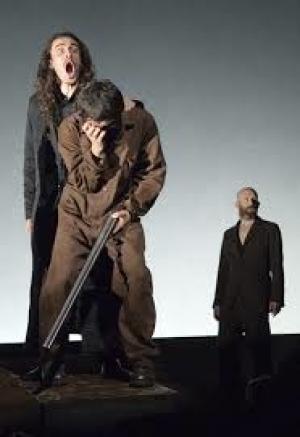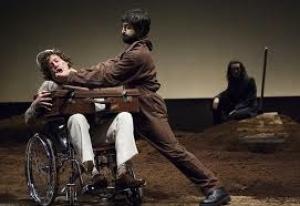The Bull (2005)
Fabulous Beast Dance Theatre for the 2005 Dublin Theatre Festival
Duration: 104’
A piano, percussion and vocal score, performed by the dancers and actors live onstage
Directed and Choreographed by Michael Keegan-Dolan
Dramaturg: Thomas Conway
Designer: Merle Hensel
Lighting Design: Adam Silverman
Sound Design: Gareth Fry
Co-produced by Fabulous Beast Dance Theatre, Dublin Theatre Festival and BITE: 06 Barbican, London. First performed at the O’Reilly Theatre 2005 as part of the Dublin Theatre Festival.
Cast: Michael M. Dolan, Colin Dunne, Olwen Fouere, Milos Galko, Robbie Harris, Emmanuel Obeya, Neil Paris, Gianluca Pezzino, Rachel Poirier, Angelo Smimmo, Vladislav Benito Soltys and Daphne Strothmann.
The Bull is unique amongst Philip Feeney’s works in that it was performed entirely by the performers themselves, and in many respects created by them. Most of it was not even written down until it came for a season to the Barbican Centre in London, when Fab Beast’s inspirational percussionist, Robbie Harris, was stricken with a bad back and it was necessary to get a replacement. It is customary to talk about the versatility of performers, but in this production the cast really did do everything – they were dancers, actors, singers, percussionists, many performing several characters.
Keegan-Dolan had assembled together an enormous array of diverse talent, that helped to make this possible. While the brilliant Olwen Fourere raised the bar as far as the acting was concerned, it was the presence of Colin Dunne, the exceptional Irish dancing champion, and the afore-mentioned Harris, that were probably central to this production. Percussion and dance sequences were fashioned over a period at Shawbrook School of Dance, directed by Philip and Anica Dawson, so that they fit not only the production but also the cast perfectly. Both Dunne and Harris, as well as constructing much of the work, exhibited a fabulous virtuosity in performance that made the show unforgettable.
The Bull is Keegan-Dolan’s fantastic interpretation of the ancient Irish epic An Táin Bó Cuailnge (The Cattle-Raid of Cooley), which tells of a long, bloody conflict over a bull and serves as a savage social critique of the Ireland of the Celtic tiger. The stage is totally covered with peat, apart from a strip of board that allowed for the Irish Dancing sequences, constructed and performed by Colin Dunne and the company, accompanied on the bodhran by Harris. Other good dancing surfaces proved to be the wooden table and half peat-covered coffin, which it was sound designer, Gareth Fry’s task to mic.
If the dancing surfaces were whatever was there, then that is even more the case with the percussion department. Buckets, shovels, the cement mixer, anything was fair game to be hit. The work ends with an epic driving percussion sequence, led by Harris on the Japanese taiko drum which leads into a fantastic unison dance for the whole company. It is the only point where there is a track, since, with more of the cast dancing, there was less actual drumming causing a drop in the intensity, something that could not be countenanced.
Earlier in the piece, there are several fore-runners of this drumming, which appear as entr’actes, and serve as powerful seismic warnings of the closing scene. It is as if there is constant rhythmic beat throughout this piece, and only occasionally does it erupt into dynamic activity.
As in most Fabulous Beast productions music is brought in from the outside, in this case embracing music with emotional baggage such as Kurt Weill or Johnny Nash’s “I can see clearly now the rain has gone”, alien and strident gestures which are given the Fabulous Beast treatment. One of the cast, the talented and irrepressible Gianluca Pezzino, played the beaten up upright piano for the epic opening overture accompanied by counter tenor, Angelo Smimmo, suspended high in the air on a ladder. Pezzino also features in some of the stormy musical scene changes that hurry the drama on. But at other times it is other members of the cast who play the piano, with a simple two-note figure that quietly, almost imperceptibly colours the narrative. Often it would be whoever was upstage stage left who would do the honours.
Feeney composed two choral sections for the Bull: an imposing contrapuntal madrigal Yi, Yi, Yi, Yi!, which is sung by the full company divided into five taxing parts as the narrative leads to its deadly climax, and a lament for five solo singers at the death of Finn, played by Daphne Stothmann – their positioning on the stage made the ensemble difficult, but effective, as it was one of the few moments where the focus was drawn inwards.
The Bull went on to be performed at Barbican Centre in February 2007, and at the Spielzeit'europa, Berliner Festspiele in November 2009. Slight changes were made for both revivals, the first engendered mainly by Harris’ indisposition and the necessity to use and extra percussionist. When The Bull went to Berlin, we kept the extra drummer (both were characters in the story) giving a better aural symmetry to the last act. The main difficulty in Berlin was the difference in the constituency of the peat, making both the speech and the singing a dustier and drier affair.
Perhaps its most genuine performance, however, was before it all got going. On the final night of the company’s sojourn at Shawbrook, there was an open-air twilight performance in Philip Dawson’s yard, covered in peat and accompanied by crows, in which the composer was privileged to be playing the stark piano overture which starts the whole thing off.




